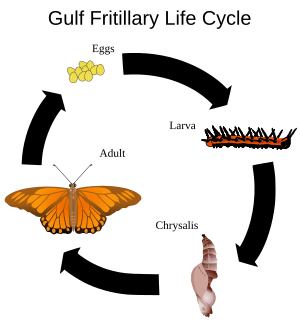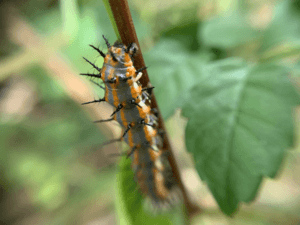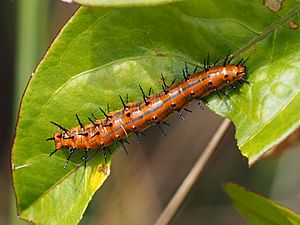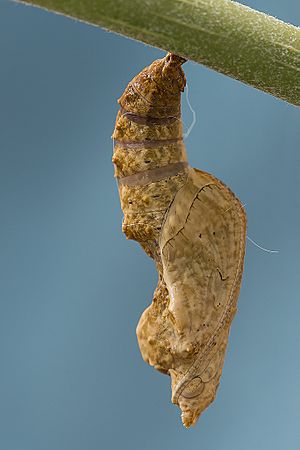Gulf fritillary facts for kids
Quick facts for kids Gulf fritillary |
|
|---|---|
 |
|
| Dorsal view | |
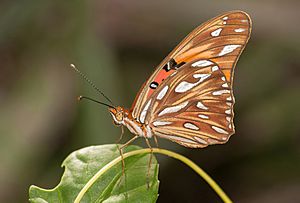 |
|
| Ventral view | |
| Conservation status | |
| Scientific classification | |
| Genus: |
Agraulis
|
| Species: |
vanillae
|
The Gulf fritillary (Agraulis vanillae) is a bright orange butterfly. It is also known as the passion butterfly. This butterfly belongs to a group called "longwing butterflies" because their wings are longer and narrower than other butterflies. The Gulf fritillary is the only type of butterfly in its genus, Agraulis.
You can usually find Agraulis vanillae in the southern parts of the United States. They are very common in places like Florida and Texas. These butterflies have a special way to protect themselves from predators. They release smelly chemicals when they sense danger. This helps teach predators to stay away from them.
The scientific name vanillae was given to this butterfly in 1758 by Carl Linnaeus. He named it after seeing a painting from 1705 that showed the butterfly on a vanilla orchid. However, we now know that Gulf fritillary caterpillars do not actually eat vanilla plants.
Contents
- What Does the Gulf Fritillary Look Like?
- Where Do Gulf Fritillaries Live?
- What Kind of Places Do They Like?
- What Do Gulf Fritillaries Eat?
- How Do Gulf Fritillaries Reproduce?
- The Life Cycle of a Gulf Fritillary
- Do Gulf Fritillaries Migrate?
- How Do They Protect Themselves?
- How Do Gulf Fritillaries Mate?
- Images for kids
- See also
What Does the Gulf Fritillary Look Like?
As an adult, the Gulf fritillary is a medium-sized butterfly. Its wingspan can be from about 6.5 to 9.5 cm (2.5 to 3.7 inches). Female butterflies are usually bigger than males.
The underside of their wings is brown with shiny, silvery-white dots. The top side of their wings is a bright orange color with black stripes. Females also tend to be darker orange and have more black stripes than males.
Where Do Gulf Fritillaries Live?
Gulf fritillaries are mostly found in the southern United States, including Texas and Florida. Their home range can stretch into Mexico and Central America. Sometimes, they even fly as far south as parts of South America. You can also find them in Hawaii. Since about 2010, they have become more common in California's Central Valley.
What Kind of Places Do They Like?
Gulf fritillaries prefer open areas. You can often see them in sunny grasslands, parks, and woodlands. They are also a common sight in butterfly gardens across the U.S.
What Do Gulf Fritillaries Eat?
The caterpillars of the Gulf fritillary eat plants from the Passiflora genus. These plants are often called passion vines. Adult butterflies drink nectar from many different flowers, like Lantana plants.
In some parts of Texas, where many Gulf fritillaries live, the caterpillars eat specific passion vine species. These include Passiflora lutea and Passiflora affinis. Passion vines are good host plants because they provide a safe place for young caterpillars to grow. Female butterflies also lay their eggs on or near these host plants.
How Do Gulf Fritillaries Reproduce?
Laying Eggs (Oviposition)
When a female Gulf fritillary is ready to lay eggs, she flies low over plants. She often looks for host plants like Passiflora incarnata or Passiflora lutea. She will pause over a plant and then land on it.
The female lays a single egg on or near the plant. She knows which plants are suitable by sensing their chemical makeup with her antennae.
The Life Cycle of a Gulf Fritillary
Egg Stage
The eggs are small and round. The female butterfly lays them one by one on or near a host plant, usually a Passiflora species. When first laid, the eggs are yellow. Over the next 24 hours, they slowly turn a brownish-red color.
The egg stage usually lasts about three to five days. The exact time depends on how warm the environment is. You can often find eggs on the top side of leaves, but sometimes they are on the underside too.
Larva (Caterpillar) Stage
Gulf fritillary larvae, or caterpillars, are dark orange with small black spikes. These spikes are soft and do not sting. They help scare away animals that might want to eat them.
Caterpillars go through five growth stages, called instars. After hatching, the new caterpillars eat their own egg casings for their first meal. Then, they start eating the leaves of the host plant. In the first three stages, they eat the leaves from the middle, away from the edges. In the last two stages, they eat from the leaf edges.
How much they eat depends on the leaf type and if there is plenty of food. The caterpillar stage lasts about 11 to 16 days, depending on the temperature.
Pupa (Chrysalis) Stage
The pupae, or chrysalises, of Gulf fritillaries can look different. They vary in color and size. This stage usually lasts about 7 to 12 days. Colder temperatures make this stage longer, while warmer temperatures make it shorter.
Metamorphosis
When a caterpillar is ready to become a chrysalis, it turns grayish. It spins a silk pad on a surface and hangs upside down in a "J" shape. Then, it sheds its skin, revealing a soft, pinkish-tan form. This soft form quickly hardens and turns grayish-brown.
The chrysalis stays in this form for 11 to 21 days. After this time, a small crack appears at the top of the chrysalis. The butterfly's head emerges first. It slowly wiggles out until its legs are free to grab onto the chrysalis shell.
Like a monarch butterfly, it then pumps fluid from its body into its shriveled wings. Once the wings are fully expanded, it releases extra fluid. It stays still for 10 to 15 minutes to let its wings dry. Finally, it fans its wings and flies away!
Adult Stage
After coming out of the chrysalis, the butterfly dries its wings and takes its first flight. There are usually about the same number of male and female adult butterflies.
Adult Gulf fritillaries live for about 14 to 27 days. How long they live depends on things like how much food is available, if there are predators around, and if they have to compete with other butterflies.
Do Gulf Fritillaries Migrate?
Gulf fritillaries are very common in Florida, and their migration patterns there are well-known. They have two main migrations each year. In the spring, large groups of butterflies fly north. In the fall, they fly south through the state, especially in the peninsular parts of Florida.
How Do They Protect Themselves?
Both male and female Gulf fritillaries have special glands on their abdomens. These glands act as a defense mechanism against predators, especially birds. When the butterflies feel danger or are disturbed, these glands release a strong odor. This smell is made of different chemicals. Birds learn to avoid Gulf fritillaries because of this smell.
Sometimes, Gulf fritillaries might also have competition with other butterfly species. This can happen if other butterflies, like the Heliconius charithonia vazquezae or Dryas iulia moderata, live in the same areas.
How Do Gulf Fritillaries Mate?
Courtship Behavior
A typical courtship interaction starts when a male butterfly flies and lands near a female. The female is usually resting on a host plant, like a Passiflora species. Once the male lands, he positions himself next to the female. Their heads are together, and their bodies are at a 45-degree angle.
The male then performs a "wing clap display." He continuously claps his wings open and closed.
Male and Female Interactions
Pheromones
Male Gulf fritillaries release special chemicals called pheromones. These pheromones are very important for mating and courtship. Males have special structures on their dorsal wings that produce and release these chemicals. Tiny pores on their wings likely help transport the pheromones to the surface, where they can be released to attract females. The use of pheromones helps females choose a mate.
Images for kids
-
Agraulis vanillae in its chrysalis form, seen in Inglewood, California
-
A. v. insularis Grand Cayman
See also
 In Spanish: Agraulis vanillae para niños
In Spanish: Agraulis vanillae para niños



